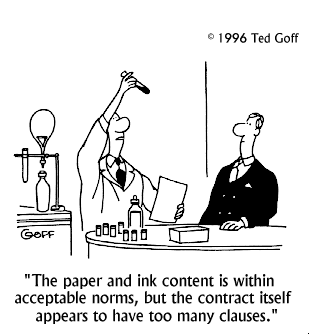
Closing deals, amiright. Not the easiest thing to do under the best of times. Throw in some legal quibbling, a misunderstanding or two, and Mercury in retrograde, and it can sometimes feel like the third circle of hell. That’s where the usurers go, by the way, so make sure you always deal fairly.
How can you ensure that you do? Why, with a letter of intent, of course.
Otherwise known as an LOI, this non-binding agreement crops up in the final stages of negotiating a deal with a large customer or partner. It stipulates multiple aspects of the agreement, such as purchase price, due diligence, and any astrological factors that may come into play. (Well, two of those, anyway.)
While it is a non-binding agreement – i.e. the other party can’t take you to court if you don’t honor it – it is an important document that makes everyone feel all warm and fuzzy on either side.
Unfortunately, just because the document itself isn’t binding doesn’t mean that lawyers can’t fight over it like cats and dogs. They can. They do. They will keep doing so unless you take action to smooth the way.
Luckily, you can! And if you’re in the final stages of a deal right now and need to send over the paperwork, you’re probably trying to figure out where to start and what to include in your LOI that will get the deal approved fast. Good news–there’s a hack for that.
Of course, in the unlikely event that our awesome hack just doesn’t work for you (we’ll explain how this could happen later), we’re also providing an LOI sample letter that will get you moving in the right direction.
What is a Letter of Intent (LOI?)
A letter of intent is a short, non-binding letter that precedes a binding agreement, such as an asset purchase agreement. Typically, it sets the future terms of an agreement (and may even include a term sheet) so that everyone feels like they’re on the same page and safe proceeding.
Generally, you don’t want to include many specifics in a letter of intent. Rather, you put in everyone’s contact information and the basic outline of the deal. Steer clear of any language that pins down exclusivity or a non-disclosure agreement, as those are usually considered legally binding.
So that’s what you should keep out of an LOI. But what should you put in?
What’s in an LOI?
All right, what should you expect to include in a letter of intent? While the exact answer to this question does vary according to the type of transaction, industry, and parties involved, the main factors include:
- The proposed transaction: What are you buying or selling? This is one of the most important aspects to include, as it stipulates exactly what the transaction comprises.
- Due diligence: What types of liabilities are likely to exist with this sale? For instance, if you are acquiring a company, what risks are involved and how will you investigate them or allow the other party to investigate? If you’re buying a house, what are the expectations for the inspection?
- Timeline: What is the specific date by which the above will get finished?
- Confidentiality: Who is allowed to know about this pending transaction? In the case of buying a home or a business complex, it’s not necessarily a big deal. Pending property transactions aren’t typically secret. However, when it comes to acquiring a company? Unless you’re Elon Musk loudly buying Twitter for, like, eight months, you probably want to keep it on the DL – and make sure everyone else does too.
- Covenants: What legal precedents, laws, and promises will apply? Generally, a covenant constitutes something you totally, absolutely, freaking promise you’re going to do, but isn’t necessarily legally binding. How does this play in?
- Exclusivity: In what ways do you swear to be faithful to the other party and only the other party, til death do you part? (And by death, we obviously mean the conclusion of the deal.)
- Special terms or conditions: Anything else that might apply here, depending on the legal issues, industry, product or service, alignment of the planets, yadda yadda.
Again, while this isn’t a binding agreement, it is important that you write as detailed an LOI as possible to prevent misunderstanding and ease the amount of legal squabbling involved.
That’s where a nicely formatted letter comes in. However, the letter format will vary slightly with the type of transaction, so let’s take a quick gander at the four main types below.
4 Main Types of Letters of Intent
There are generally four types of LOI. While they all convey the same basic idea – you are acting in good faith and intend to honor the informal or verbal agreement you’ve already made with the other party – there are distinct facets of each. Let’s take a look.
- Business letter of intent: This is appropriate for large and small business deals alike, and it explains the terms of the deal, e.g. money in exchange for a service, according to the nature of the potential transaction.
- Letter of intent to purchase personal property: When a large purchase is at stake, you might create an LOI. This is sometimes done for vintage cars or expensive equipment.
- Letter of intent to purchase real estate: This letter of interest is exchanged between a potential buyer and seller of a piece of property and usually lays out lender rules and other legal stipulations.
- Letter of intent for other transactions: Lastly, you can create an LOI for other transactions that require legal advice and lengthy negotiations. Think selling a client list or a business, for example.
No matter what your letter includes, make sure to include all contact info, such as a mailing address, and any potential legalities that will ensue upon signing the letter.
The Typical (and Time-Consuming) LOI Process
 |
Even if you use a good LOI template, you’ll often find that it creates a lot of friction. It’s time-consuming and obnoxious, and it’s not always clear how you should fit it into your normal workflow. Here’s what the typical process looks like:
- You download a template online and tweak it to your own needs with the help of your lawyer, or you use a friend's LOI
- You send your LOI to your customer
- Your customer sends your LOI to their legal department
- Their legal department will dissect your LOI as if they’re the CSI investigating a high-profile murder case. They’ll go over every line, every single word to make sure that it’s 100% waterproof. The legal department doesn’t care how long this takes. They just want it to be safe for the company to sign. They want to put themselves in as favorable a legal position as possible. If you grow a beard in the process, it’s no skin off their noses
- Then they’ll make edits and comments and send those back to your buyer
- Your buyer will then send those over to you
- You’ll adjust your wording according to their requests together with your lawyer
- You send the revised LOI back to the buyer
- They send it to legal again
Rinse, repeat. Rinse and repeat again! Assume there can’t possibly be any more rinsing and repeating … but then, surprise!
It’s like a big legal ping-pong match between lawyers.
Wasting a lot of time in the contracting stage is something you want to avoid as much as possible. Besides being a one-way ticket to Ulcerville, it can even starve a good deal to death.
The answer? The right templates, ones that actually work, that actually speed up the process, and that actually meet the needs of your specific buyer.
How to Get the Right LOI Template for Your Buyer
Rather than trying to come up with a letter of intent in a vacuum, you ask them for one, and use that as your template!
Call up your buyer and say:
“Have you bought something similar in the last year or two that went through procurement and legal and got green-lighted? If you have a deal like that, can you share that letter of intent or contract with us?”
The buyer will send it over to you, and bam, you have your perfect LOI template for this buyer. Just edit it to your needs.
 |
The big advantage is that it’s pretty much already pre-approved. You’re using the wording their legal department is comfortable with.
You’ll get through their legal department a lot faster, they’ll sign sooner, and you can close the deal quicker.
You get their money, and they get your solution earlier. And you can perform that favorite change in your sales CRM: changing the lead status to “closed.” Everybody is happy… except maybe the lawyers who are being paid by the hour. ;)
Need to Draft Your Own LOI? Start Here
What? Your client doesn’t have a pre-approved LOI sample to provide, and you need to start from scratch?
We got you.
The LOI sample template we’ve provided below is a great free letter of intent template to begin with, and it works for all four of the above-mentioned LOI types. All you have to do is fill in the blanks, put the Pepto away, sit back, and relax.
We do recommend saving it as a Word template (or using it in any other word processing software) if you want easy access to it for future use. As you customize it for different transactions, be sure to save all of the different versions of letter of intent templates you create under clear, easily distinguishable document names so you have easy access when you need them next.
LOI Sample Template
[Your contact information]
[Their contact information]
Dear [Buyer],
This letter of intent represents basic terms for an agreement between the buyer (“Buyer”) and seller (“Seller”) noted below. This Letter of Intent is a precursor to a definitive agreement and binding contract.
For the purposes of this transaction, the Buyer is [Buyer’s name], residing at [Mailing Address], and the Seller is [Seller’s name], residing at [Mailing Address].
The transaction involves the Buyer paying the Seller the previously agreed upon amount of [purchase price spelled out] ($XXXXX.XX) (“Purchase Price”) in exchange for [description of the product/service/property/patent/etc. for sale). We’ve agreed to finalize this deal by [specify date and year], unless both parties agree to an extension.
Once due diligence has been completed, payment is expected as follows:
Upon Signing: The Purchase Price must be paid at the time of signing
At a Later Date: The Purchase Price must be paid by [specify date and year], or as mentioned in the formal agreement.
Other: _______________________________________
Upon receipt of payment, the Seller will [describe actions required, such as transferring ownership, creating account logins, etc.] by [specify date and year].
The process of creating a binding contract will initiate upon your acceptance of this letter or [date], whichever is sooner. Thank you,
[Your name and/or signature]
Okay, so now you have your sample letter of intent. File it away with your other boilerplate legal documents, sales contracts and serenity mantras. After all, even a great LOI can’t save you from lawyers all the time.
Still, with this in your back pocket, you’ll have a lot easier time getting to that vaunted “closed” status.
Other things that can help you close deals? Great email automation, cold calling scripts, sales team training capabilities, list segmentation, and user-friendly CRM dashboards.
Turns out, Close can help you close much faster with all of the above – and we’d love to help you get started today. If you want to learn more about our cutting-edge, award-winning customer resource management software, we’d love to show you a quick demo.
Or you can jump right in with a 14-day free trial now. Now you can speed up your sales pipeline and keep Legal off your back all in one place, so don’t wait to get started today!









